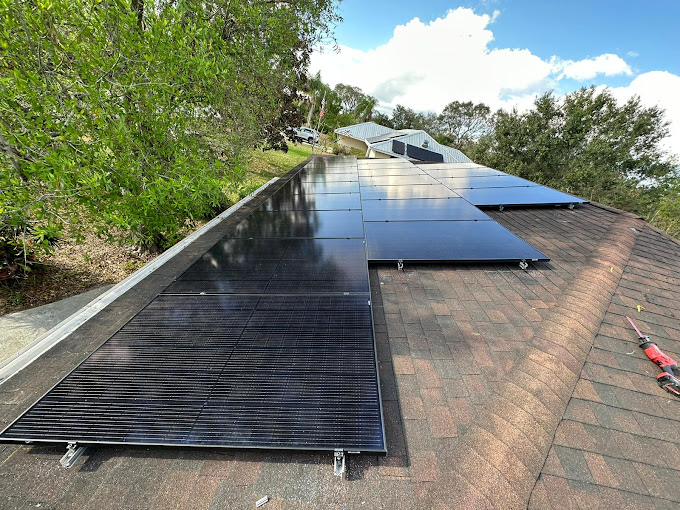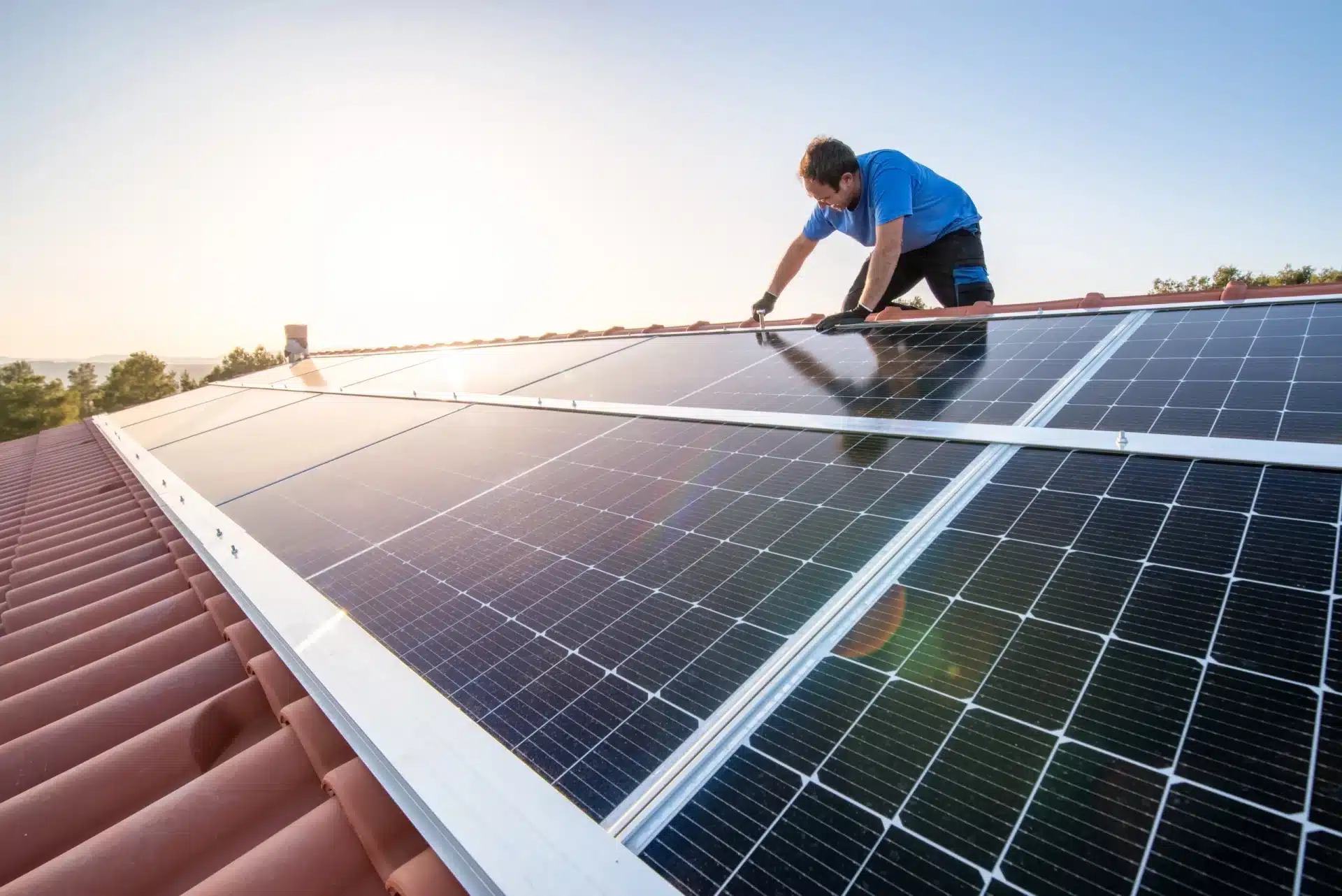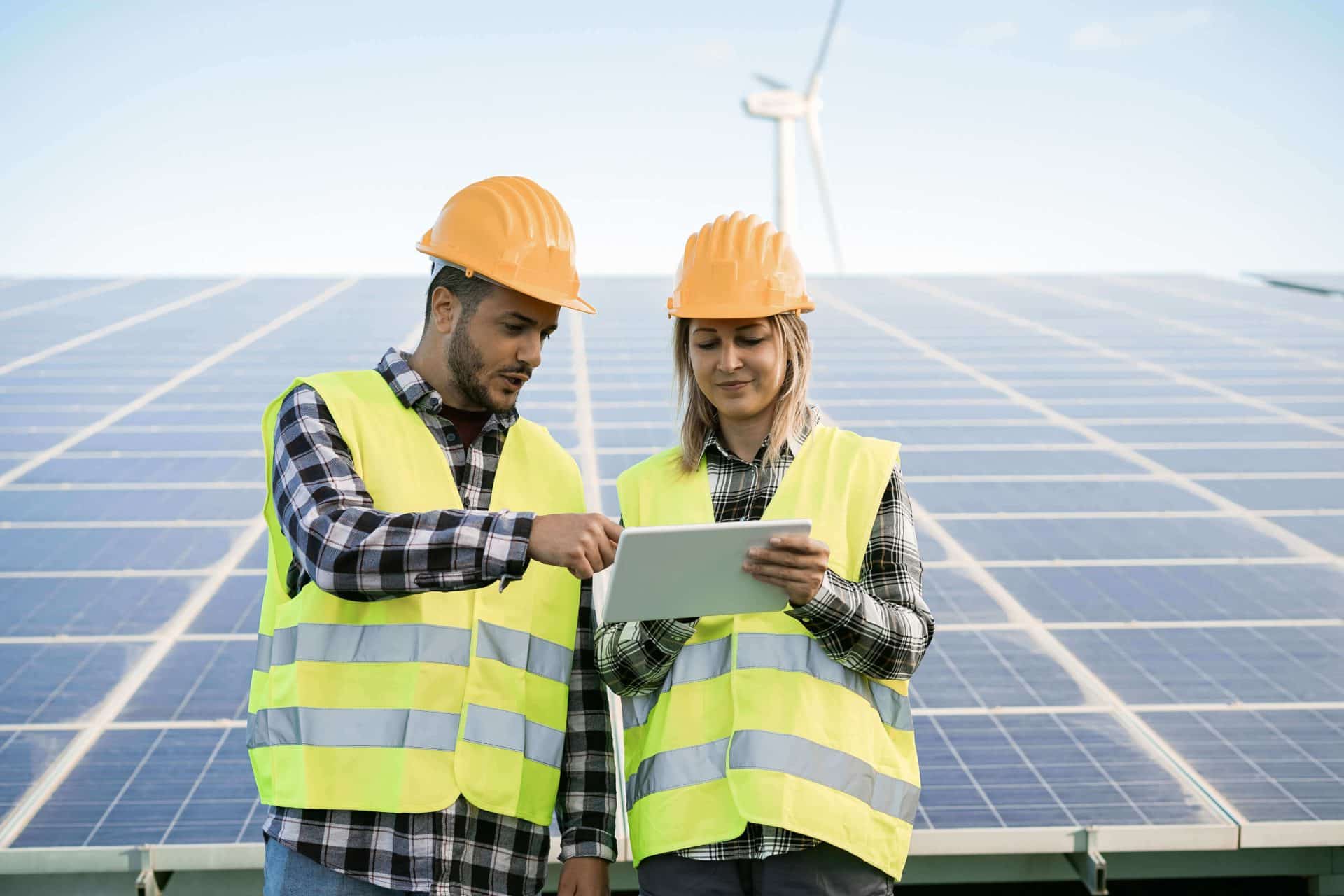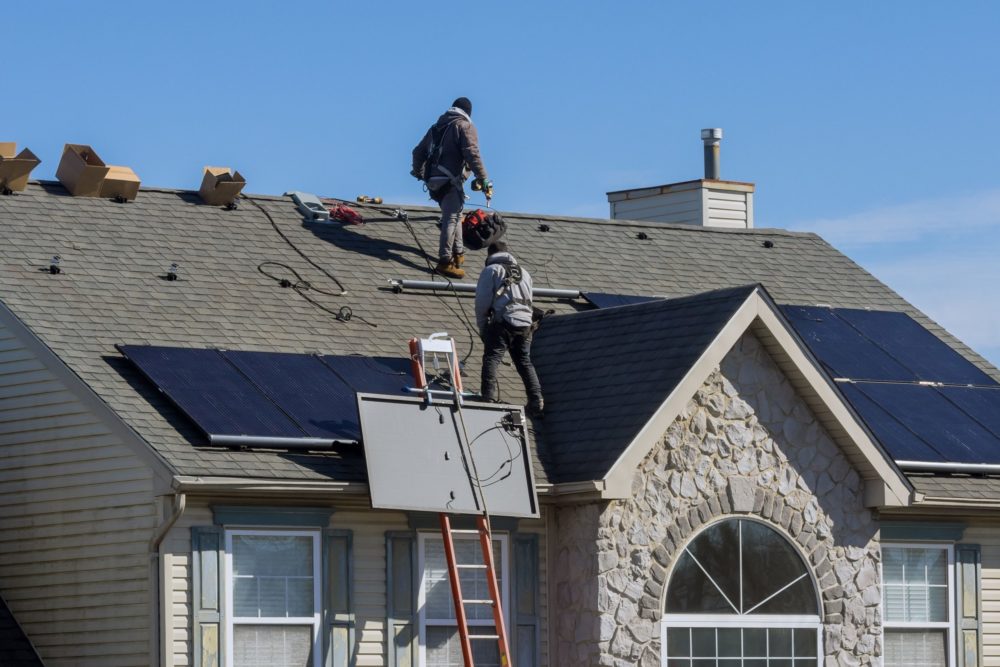When harnessing solar energy for your flat roof, IntegriSolar is your trusted solar installation company in Ocala, FL, providing comprehensive solutions tailored to your needs. Exploring the intricacies of installation reveals critical factors that can significantly influence your system’s effectiveness. From meticulously positioning panels to ensuring proper weight distribution and compatibility with your roof material, every detail contributes to the overall performance of your solar setup. However, overlooking elements such as solar panel tilt angle and shade analysis can impact efficiency.
At IntegriSolar, we understand the importance of addressing these often neglected factors. Our team is dedicated to thorough assessments, considering all aspects, including maintenance access, electrical wiring, permitting requirements, and seamless monitoring system integration.
With our expertise and attention to detail, we ensure that your flat roof solar installation meets and exceeds expectations, delivering optimal performance and energy savings for years to come. Trust IntegriSolar to illuminate your path towards sustainable energy solutions.
Key Takeaways
- Ensure proper weight distribution for structural safety and optimal energy production.
- Consider panel orientation and tilt angle for maximum sunlight exposure.
- Use aerodynamic racking systems to mitigate wind load impact on flat roofs.
- Install quality electrical wiring with a strategic layout to minimize energy loss.
Research local regulations, obtain permits, and integrate monitoring systems for efficient operation.
Roof Orientation
IntegriSolar, your trusted solar providers in Ocala, FL, understands the significance of roof orientation when it comes to optimizing the efficiency of your solar installation. It’s a crucial consideration in the planning phase of solar panel installation on a flat roof. The orientation of your flat roof plays a pivotal role in determining the amount of sunlight your solar panels receive daily. Ideally, south-facing roofs maximize sun exposure, particularly in the northern hemisphere, ensuring optimal energy generation. However, east and west-facing roofs can also be viable options depending on your specific circumstances.
Before proceeding with the solar installation, it is advisable to consult with a reputable solar company or solar installers, such as IntegriSolar in Ocala, FL. Our professionals can assess your flat roof’s orientation and determine the best placement for the solar panels to ensure efficient energy production. We consider factors such as shading from nearby buildings or trees, roof tilt, and any obstructions that could hinder sunlight exposure.
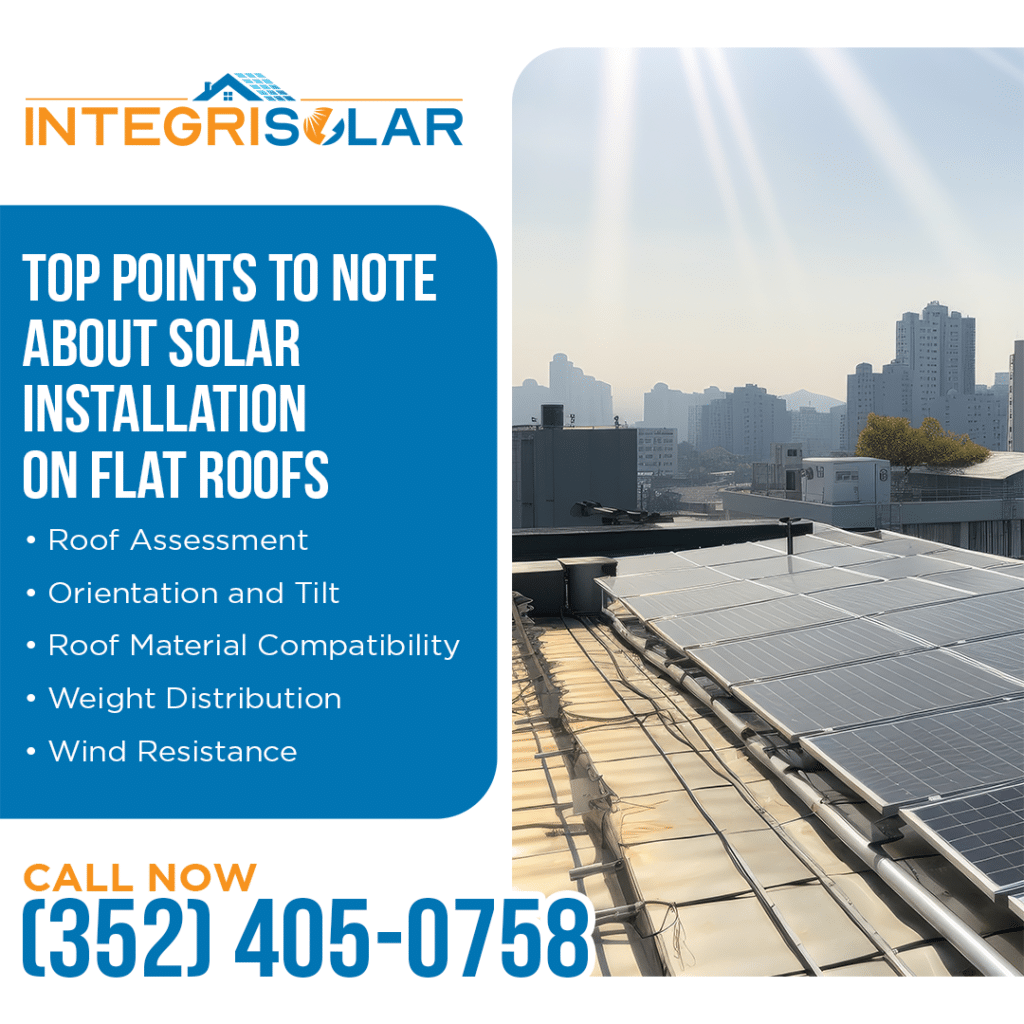
Ensuring the proper orientation of your flat roof for solar installation is vital for maximizing energy efficiency and savings. By working with experienced solar installers like IntegriSolar, you can make informed decisions that will benefit your energy consumption and the environment. Optimizing your flat roof’s orientation for solar panel installation will help you make the most of its potential.
At IntegriSolar, we prioritize meticulous planning to leverage your roof’s orientation effectively. Our team assesses your roof’s positioning and recommends the most suitable installation approach to harness maximum solar energy. IntegriSolar will guide you towards a sustainable energy solution tailored to your needs and optimized for efficiency.
Weight Distribution
When determining the best placement of solar panels on a flat roof, it’s important to consider the weight distribution to guarantee structural integrity and safety. Proper weight distribution ensures that the roof can support the solar panel’s added load without collapsing. As a leading solar installation company in Ocala, FL, IntegriSolar prioritizes conducting thorough assessments to determine the ideal layout that distributes weight evenly across the roof surface.
Solar installation companies like ours in Ocala, FL, employ specialized techniques to calculate the weight distribution of solar panels based on factors such as panel size, material, and mounting system. By working with our experienced solar providers in Ocala, FL, homeowners can rest assured that the installation process will be handled with precision to avoid any structural issues in the future.
Our team at IntegriSolar, the trusted solar installation company, understands the importance of adhering to weight distribution guidelines set forth by manufacturers and industry standards. By following these guidelines, we can ensure the solar panel system’s longevity and the property’s safety. Homeowners can trust our expertise in balancing weight distribution effectively to maximize energy production while safeguarding the integrity of their flat roofs.
Roof Material Compatibility
When considering solar panel installation, IntegriSolar, as a leading solar installation company, acknowledges the significance of the roof material. Your roof’s material influences the feasibility and success of the installation process, particularly on flat roofs.
At IntegriSolar, we have the expertise to assess the compatibility of your roof material with solar panel installation. Our team meticulously evaluates your roof’s structural integrity and characteristics to recommend the most suitable installation approach. With our dedication to precision and quality, you can trust IntegriSolar to deliver a tailored solar solution that seamlessly integrates with your flat roof, ensuring lasting performance and reliability.
Here are some key points to ponder regarding roof material compatibility:
- Flatness: The flatter the roof material, the easier it is to install solar panels. Materials like metal or TPO (Thermoplastic Polyolefin) are typically smoother and more conducive to solar panel placement than materials with a textured surface.
- Weight Bearing Capacity: Different roof materials have varying weight-bearing capacities. It is essential to confirm that the roof material can support the additional weight of the solar panels, racking system, and any potential snow or water accumulation.
- Heat Absorption: Roof materials that absorb a lot of heat, such as asphalt, can affect the efficiency of solar panels. Opting for materials that reflect sunlight can help maintain the panels’ performance levels.
- Durability: The durability of the roof material is crucial for the long-term success of the solar panel installation. Ensure that the material can withstand exposure to the elements and securely support the panels over time.
Solar Panel Tilt Angle
As a leading solar installation company in Ocala, FL, IntegriSolar recognizes that determining the optimal tilt angle for panels is crucial for maximizing energy production. The tilt angle, referring to the angle at which panels are positioned relative to the horizontal plane, significantly influences their exposure to sunlight year-round.
The ideal tilt angle for solar panels on a flat roof varies depending on factors such as the location’s latitude, the property’s specific energy needs, and the time of year when energy production is most important. In general, for locations near the equator, a tilt angle close to the area’s latitude is often recommended. This allows for maximum exposure to sunlight year-round.
However, for regions further from the equator, adjusting the tilt angle to be more perpendicular to the sun’s rays during winter can boost energy production when sunlight is less intense. Additionally, a slightly steeper tilt angle can help reduce the impact of dust accumulation or snow buildup on the panels, aiding in maintaining peak performance.
Taking these factors into account when determining the tilt angle for solar panels on a flat roof is essential to ensuring efficient energy production and maximizing the benefits of solar installation. IntegriSolar’s expertise ensures meticulous consideration of factors like roof material and geographical location to recommend the most suitable tilt angle for your solar panels. By optimizing exposure to sunlight throughout the day and across seasons, we maximize your system’s energy output, providing you with greater efficiency and long-term savings. Trust IntegriSolar to tailor your solar solution for optimal performance and sustainability.
Shade Analysis
At IntegriSolar, a leading solar installation company, our shade evaluation process is integral to our meticulous approach to optimizing solar panel performance. We thoroughly assess the impact of surrounding objects or structures on sunlight exposure to ensure maximum energy production.
Before installing solar panels, it’s crucial to identify and address any potential shading issues. Our expert team conducts comprehensive shade evaluations, considering factors such as nearby trees, buildings, or other obstructions that may affect sunlight access. We maximize your system’s efficiency and long-term energy production by identifying and mitigating shading issues upfront.
Here are some key points to keep in mind:
- Tree Coverage: Tall trees near the flat roof can cast shadows on the solar panels, reducing efficiency. Trimming or removing trees may be necessary to avoid shading.
- Adjacent Buildings: Nearby structures can also create shading issues depending on their height and proximity to the solar panels. Analyzing the shadow patterns throughout the day is essential.
- Vent Pipes and Chimneys: Roof features like vent pipes and chimneys can create shadows on the panels. Proper placement of solar panels considering these elements is crucial for good performance.
- Future Shading: It is important to anticipate potential shading from new constructions or growing vegetation. Planning for long-term unobstructed sunlight exposure is key to solar installation efficiency.
Trust IntegriSolar to deliver a tailored solar solution that minimizes shading impact and maximizes your investment’s return. With our commitment to excellence, we ensure your solar panels receive optimal sunlight exposure, providing you with sustainable energy solutions for years to come.
Wind Load Considerations
Considering the impact of wind load is vital when planning a solar installation on a flat roof. Wind can exert significant force on solar panels, especially when mounted on a flat surface like a roof. To guarantee the stability and longevity of the solar array, it is essential to consider wind load considerations during the design and installation process.
Engineers use techniques such as ballast systems, wind deflectors, and aerodynamic racking systems to mitigate the impact of wind load. Ballast systems, which use weights to secure the solar panels, are commonly used on flat roofs to provide stability. Wind deflectors help redirect airflow around the panels, reducing the pressure exerted on them. Aerodynamic racking systems are designed to minimize wind resistance and enhance the overall structural integrity of the solar array.
In assessing wind load for solar installations, IntegriSolar, a trusted solar installation company, considers a range of factors to ensure your system’s structural integrity and longevity. Geographic location, building height, and surrounding terrain are all critical considerations.
Variances in wind speeds and patterns across different regions directly impact the force exerted on solar panels. Moreover, taller buildings face heightened exposure to higher wind speeds, necessitating additional support or anchoring to withstand such forces.
IntegriSolar’s thorough evaluation process accounts for these factors, ensuring that your solar installation is resilient and built to withstand your location’s unique environmental challenges. With our expertise and attention to detail, you can trust IntegriSolar to deliver a reliable solar solution tailored to your needs and geographic context.
Maintenance Access
Guaranteeing proper maintenance access is crucial for the longevity and efficiency of a solar installation on a flat roof. Without easy access for maintenance, issues may go undetected, leading to decreased performance or even damage to the system over time. Here are some key points to keep in mind regarding maintenance access:
At IntegriSolar, safety is our top priority in every solar panel installation and maintenance aspect. Here are some key considerations to ensure the safety and efficiency of your solar system:
- Safety First: We prioritize safety by designing maintenance access points with sturdy ladders, non-slip surfaces, and appropriate guardrails to prevent accidents and ensure secure access for maintenance personnel.
- Clear Pathways: IntegriSolar ensures clear pathways to the solar panels, facilitating easy inspection and maintenance. Removing obstacles ensures swift access to panels when needed, minimizing downtime and maximizing system efficiency.
- Regular Inspections: Scheduled inspections are integral to maintaining optimal performance. Our team conducts thorough assessments to check for debris buildup, damage, or any issues that could impact panel efficiency. A clear maintenance schedule helps prevent major problems and ensures your system operates at peak performance.
- Professional Assistance: Professional maintenance services may be necessary at regular intervals to ensure proper care for your solar installation. Our team can provide these services as needed.
With IntegriSolar’s commitment to safety and meticulous maintenance practices, you can trust that your solar installation will continue to deliver reliable and efficient performance for years.
Electrical Wiring
When ensuring the proper maintenance access for a solar installation on a flat roof, attention to detail in the electrical wiring is essential for peak system performance and safety. Proper electrical wiring is crucial to guarantee that the solar panels generate electricity efficiently and safely. During installation, all electrical wiring must be securely connected and insulated to prevent any electrical faults. It is important to use high-quality wiring materials that are durable and weather-resistant to withstand outdoor conditions on a flat roof.
Additionally, the electrical wiring layout should be designed strategically to minimize energy loss and optimize the solar system’s performance. Proper wiring connections between the solar panels, inverters, and the main electrical panel are crucial for the seamless flow of electricity. Any errors in the wiring can lead to decreased energy production and potential safety hazards.
At IntegriSolar, we emphasize the importance of regular maintenance and inspections for the electrical wiring of your solar installation. As a trusted solar installation company, we understand that ensuring your system’s ongoing efficiency and safety is paramount.
Regular maintenance and inspections are essential to identify any signs of wear and tear, damage, or loose connections in the electrical wiring. Our team of qualified electricians is equipped to promptly address any issues, minimizing safety risks and optimizing system performance.
Prioritizing attention to detail in the electrical wiring of your solar installation on a flat roof yields multiple benefits. By maximizing energy production, prolonging the system’s lifespan, and safeguarding your property, you can enjoy peace of mind knowing your investment is protected.
Trust IntegriSolar to deliver comprehensive maintenance services tailored to your solar installation’s needs, ensuring continued efficiency and safety for years.
Permitting Requirements
What are the necessary steps for obtaining the required permits for a solar installation on a flat roof? When it comes to installing solar panels on a flat roof, obtaining the necessary permits is an important step in the process.
At IntegriSolar, we understand the importance of navigating local regulations and permitting requirements for your solar installation project. Here’s a step-by-step guide to help streamline the process:
- Research local regulations: Research your area’s specific regulations and permitting requirements. Contact your city or county building department to clarify the rules and procedures applicable to solar installations.
- Submit permit applications: Once you have a thorough understanding of the requirements, proceed to submit permit applications to the relevant authorities. These applications typically entail providing details about the solar panel system, structural considerations, and electrical plans.
- Schedule inspections: Following permit approval and before commencing the installation, schedule inspections at various stages of the project. These inspections are crucial to ensuring that the installation meets safety and quality standards mandated by local regulations.
- Finalize paperwork: Upon completion of the installation and successful passage of all inspections, it’s essential to finalize all paperwork with the permitting authorities. This may involve submitting final documentation and obtaining a certificate of completion to validate the legality and compliance of your solar system.
Count on IntegriSolar to guide you through every stage of the permitting process, ensuring compliance with local regulations and a smooth transition to renewable energy. With our expertise, we’ll help you navigate the paperwork maze and facilitate a hassle-free solar installation experience.
Monitoring System Integration
Integrating the monitoring system into the solar installation process enhances the system’s efficiency and performance. By seamlessly incorporating monitoring technology during the installation phase, we can guarantee that the system operates at its best and delivers the expected results.
One key benefit of integrating a monitoring system is the real-time data it provides. This data allows us to track the system’s performance continuously, identifying any issues promptly and enabling timely maintenance or repairs. With this proactive approach, we can maximize energy production and minimize downtime, ultimately increasing the overall effectiveness of the solar installation.
Moreover, monitoring system integration offers enhanced visibility into the system’s output. By monitoring factors such as electricity generation, energy consumption, and system uptime, we can gain valuable insights into how the solar installation is performing. This data helps optimize energy usage and allows for better decision-making regarding system upgrades or expansions.
In addition to our meticulous installation process, IntegriSolar emphasizes the importance of integrating a monitoring system into your solar setup. This system enables remote monitoring capabilities, allowing access to real-time data and performance metrics from any location.
Remote monitoring provides invaluable convenience and accessibility. In the event of any irregularities or issues, immediate action can be taken to address them, ensuring the uninterrupted operation of your solar installation and maximizing its efficiency.
At IntegriSolar, we prioritize the seamless integration of monitoring systems into our installations. Knowing that your solar system is continuously monitored and optimized for peak performance provides peace of mind. Trust IntegriSolar, your local solar installation company in Ocala, FL, to deliver cutting-edge solutions that ensure the long-term success of your solar investment. Contact us today for a free consultation.
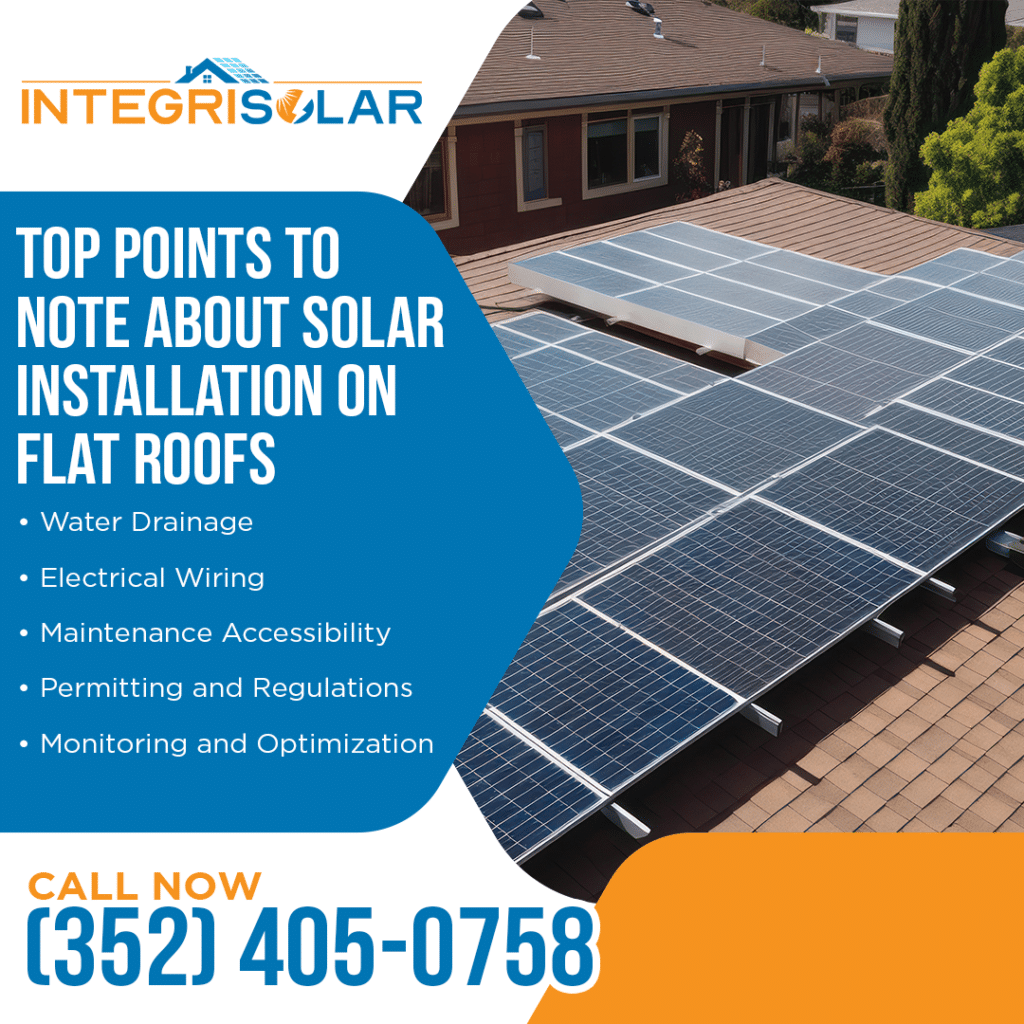
Frequently Asked Questions
Can Solar Panels Be Installed on a Flat Roof With a Slight Slope?
Certainly, at IntegriSolar, we affirm that solar panels can indeed be installed on a flat roof with a slight slope. However, we highly recommend consulting with our professional solar installers in Ocala, FL, to assess the specific conditions and ensure proper installation.
Factors such as panel orientation and potential shading must be carefully evaluated to maximize energy generation. Additionally, the installation may require proper mounting hardware and adjustments to accommodate the slope and secure the panels effectively.
With the expertise and guidance of our team at IntegriSolar, solar installation on a slightly sloped flat roof is feasible and can also be optimized for efficiency and reliability. Trust us to deliver tailored solutions that harness the full potential of your solar investment.
Are There Any Special Considerations for Installing Solar Panels on a Green Roof?
At IntegriSolar, we understand that installing solar panels on a green roof presents unique considerations that require careful attention. Here’s what you need to know:
Factors such as the additional weight of solar panels on the vegetation and the roof’s structural integrity must be thoroughly evaluated. Proper waterproofing and root protection measures are essential to safeguard against potential damage to the roof and its underlying structure.
Moreover, shading from surrounding plants or structures can impact solar panel efficiency. Therefore, strategic panel placement is crucial to maximize energy production while minimizing shading effects.
Planning and consulting with experts, like those at IntegriSolar, can ensure a successful green roof solar installation. Our team will work closely with you to assess your roof’s conditions and develop a tailored solution that integrates seamlessly with your green roof while maximizing solar energy generation.
With our expertise and commitment to quality, you can trust IntegriSolar to deliver reliable and sustainable solar solutions for your green roof.
How Do Extreme Weather Conditions Affect Solar Panel Performance on a Flat Roof?
At IntegriSolar, we understand the potential impact of extreme weather conditions on solar panel performance, especially on flat roofs. As a trusted solar installation company, we prioritize ensuring the durability and longevity of your system in all conditions.
High temperatures can reduce panel efficiency, while heavy snow or hail poses a risk of damage. However, our meticulous installation process and regular maintenance services can effectively mitigate these risks.
When planning your solar energy system, it’s crucial to consider the local climate. IntegriSolar’s team of experts can guide you in selecting durable equipment and developing a maintenance plan tailored to your specific climate conditions. With our commitment to quality and expertise in navigating weather-related challenges, you can trust IntegriSolar to deliver a resilient solar energy system that performs optimally year-round.
What Are the Best Practices for Preventing Ponding Water Around Solar Panels?
At IntegriSolar, we prioritize the prevention of ponding water around solar panels to safeguard the integrity and performance of your system. As a leading solar installation company, we implement several best practices to achieve this:
- Ensuring Proper Roof Slope: We guarantee the appropriate roof slope for efficient drainage, minimizing the risk of ponding water accumulation.
- Installing Perimeter Drains or Scuppers: IntegriSolar installs perimeter drains or scuppers to facilitate the controlled water flow away from solar panels and prevent water pooling.
- Using Ballast Blocks: We utilize ballast blocks to elevate panels, further mitigating the risk of water accumulation and ensuring proper drainage.
- Regular Maintenance Checks: Our team conducts regular maintenance checks to promptly identify and address any leaks or damages, preventing potential issues from escalating.
By adhering to these best practices and implementing proactive maintenance measures, IntegriSolar ensures your solar panel system’s longevity and optimal performance. Trust us to deliver reliable solutions that protect your investment and maximize its energy output for years.
Are There Any Specific Requirements for Installing Solar Panels on a Historical Building With a Flat Roof?
When undertaking a solar panel installation project atop a historical building with a flat roof, IntegriSolar recognizes the paramount importance of preserving the building’s integrity and historical significance. As a trusted solar installation company, we adhere to specific requirements to ensure that the installation process respects the unique character and heritage of the structure.
Our approach involves close collaboration with preservation experts to carefully assess the building’s historical significance and determine the best approach that balances energy efficiency goals with historical preservation standards. We prioritize solutions that seamlessly integrate renewable energy technology while preserving the building’s architectural integrity and cultural value.
At IntegriSolar, we understand the delicate balance between modern sustainability and historical preservation. Trust our team to deliver tailored solutions that honor the building’s legacy while harnessing solar energy for a sustainable future.
Conclusion
In summary, when contemplating solar installation on a flat roof, IntegriSolar emphasizes the importance of addressing several key factors to ensure optimal performance and longevity:
- Proper Orientation: Ensure panels are positioned to maximize sun exposure.
- Weight Distribution: Distribute weight evenly to prevent structural strain.
- Roof Material Compatibility: Select mounting options compatible with the roof material.
- Panel Tilt Angle: Optimize tilt angle for maximum sunlight absorption.
- Shade Analysis: Consider potential shading to mitigate efficiency loss.
- Maintenance Access: Ensure easy access for inspections and upkeep.
- Electrical Wiring Quality: Use high-quality wiring to maintain system efficiency.
- Permitting Requirements: Adhere to local regulations and obtain necessary permits.
- Monitoring System Integration: Implement a monitoring system for performance tracking.
Addressing these key points will guarantee that your flat roof solar installation meets efficiency standards, maintains durability, and complies with regulatory requirements. Trust IntegriSolar to deliver a comprehensive solution tailored to your needs, ensuring peak performance and long-term success. Contact IntegriSolar’s Chris Barrow at (352) 405-0758 to inquire about tax credits and potential savings today.

